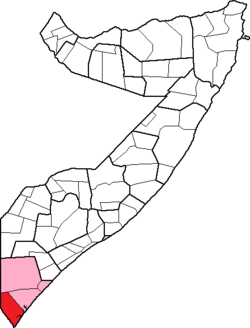This article needs additional citations for verification .(June 2019) |
Badhaadhe Joore | |
|---|---|
 | |
| Coordinates: 1°02′00″S41°29′47″E / 1.0332°S 41.4965°E | |
| Country | |
| Region | Jubbada Hoose |
| Population | |
• Total | 210,000 |
| Time zone | UTC+3 (EAT) |
The Badhadhe District (Somali : Degmada Badhaadhe) is a district in the southern Lower Jubba Region of Somalia. Badhaadhe consists of Ras Kamboni, Kolbiyow, Hosingo, Waldena, Bulla Haji and islands such as Kudhaa.